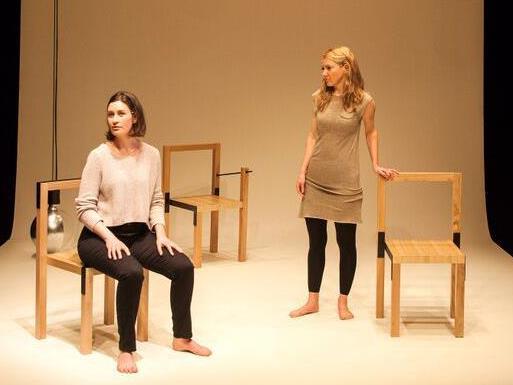Photo: Pia Johnson
There are only two things wrong with They Saw a Thylacine: the title and the poster. Both of them threaten to undersell a jewel-like work, small but perfectly formed which deserves to be sold out immediately.
They Saw a Thylacine began life as an independent Fringe Festival production where it won the touring award and was picked up for this Malthouse season. At a time when the fate of independent artists and small to medium companies is the subject of extensive political concern, it is a perfect exemplar of why the majors – and their audiences – need the creativity, agility and sheer raw talent of the independent sector.
Thylacine (I don’t hate the title but I had too many people say ‘What?’ when I mentioned it to believe it works) is a two-hander created and performed by two extraordinarily accomplished women Justine Campbell and Sarah Hamilton.
Each woman inhabits a character who tells her story of an encounter with one of the last of the now extinct species, the thylacine or Tasmanian tiger.
Hamilton is Beattie, a thylacine tracker, pursuing an elusive thylacine to sell to a zoo. She is a woman who lives close to nature and has an almost animal understanding of the creature as a noble foe. Campbell is Alison Reid, a real woman who grew up at Beaumaris Zoo in Hobart and formed a bond with the last captured thylacine. She is a woman trapped in her time, forced to stand by as ignorant men neglect a beautiful creature.
The two tales, woven together, are told with an extraordinary lyricism – almost poetic language that elevates the narratives to mythic proportions and emphasises how much is at stake. They are acted with absolute command and utter believability, so that, despite the simplicity of the set and the lack of theatrical trickery, we are totally transported.
Hamilton’s character speaks in a raw patois, possibly she is Indigenous, certainly she has lived a life that takes its rhythms from the natural world not the school room. She is proud and expansive, a confident woman with a mastery of her open world and an unsentimental attachment to the animals she hunts.
Campbell gives us a wry and knowing woman in a man’s world, darkly humorous with a syncopated poetic beat that manages to use rhyme without being twee – almost an unknown accomplishment in anything written beyond 1900.
The pair also produce occasional additional characters to enhance their narratives. Campbell is almost spookily convincing when she produces a deep baritone and switches into the character of a competing hunter, armed with a gun and attitude Beattie gives short shrift. As a bureaucrat, a zoo administrator with more interest in budgets than animals, she is unhappily familiar.
The actors wear everyday clothes and use the simplest of sets so the strength of the performances is everything – and Cambell and Hamilton do give us everything – emotion, narrative, beauty and meaning through the sheer magic of words and movement.
They Saw a Thylacine contains some powerful social comment both environmental and feminist but it is never polemical or even political. The metaphors for ignorance and the loss of the natural world are there for the taking but what we are given is a beautiful, human, poetic work that brings us into the world of its characters and gives us an hour of pure theatre.
Rating: 5 stars out of 5
They Saw a Thylacine
Malthouse Theatre
15 September to 4 October
Tickets





